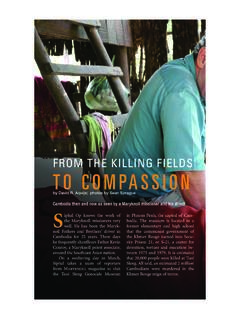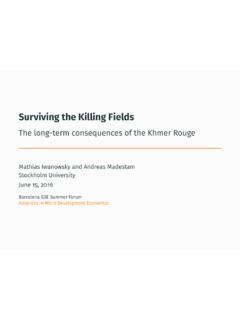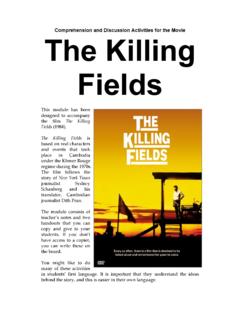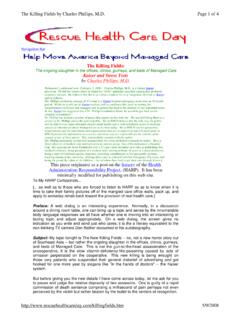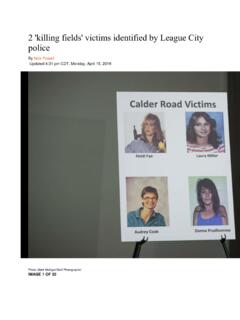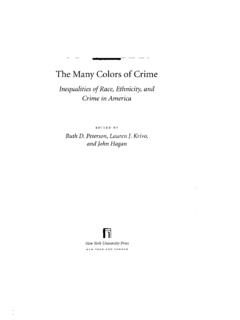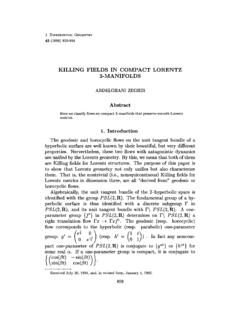Transcription of 7Sept11 CECG NC Audio Tour Script English As Recorded …
1 CHOEUNG EK GENOCIDAL CENTER. THE killing FIELDS. Narrowcasters Audio Tour English 7 September 2011. As Recorded Script Final Media Version Narrowcasters Cambodia Co., Ltd. All Rights Reserved 2. Stop 1 Introduction and walk to Stop 2. SFX Oh Phnom Penh' music only in clear for a few seconds. Music fades as narrator starts. Music out around The killing Fields.'. NARRATOR: Hello, my name is Ros Kosal. I'd like to thank you, first of all, for coming to the Choeung Ek Genocidal Center, known to many as The killing Fields. I know this is not an easy place to visit unlike our beautiful National Museum or Royal Palace in Phnom Penh but we are grateful that you have come here today to see this place of memory, and of healing.
2 Before we get going, please make sure you know how to work your Audio player. It has a pause button -- and also a rewind button, in case you'd like to hear something over again on this Narrowcasters tour. If you're ready, let's start walking now toward Stop number 2. As you can see on your map, it's to the right, before you get to the tall Memorial Stupa. The stupa will be our last stop. On your way to number 2, let me tell you a bit more. I was born in Phnom Penh, and I am Cambodian. Every one of us suffered, in one way or another, after what happened in our beautiful country on 17th April, 1975. That day, the fanatical leader Pol Pot destroyed our world and replaced it with his deranged vision of a pure' communist society.
3 I was lucky I managed to escape the killing fields ---but after leaving Phnom Penh on April 17, 1975, my family was separated and we rarely heard any news of each other. We were sent to Prey Veng Province, known in the Khmer Rouge era as the Eastern Zone --- all nine of us --- my father and mother, my four sisters, my two brothers and I. It was terrible, not knowing whether they were alive or not. My father and my mother lived and worked as farmers in the village of Kompong Popil. My youngest sister lived with them but she labored in the fields too. But I was not with them I lived and worked in what was called a mobile teenager labor unit.
4 Only after Cambodia was liberated on January 7, 1979 were we reunited again. But there were only four of us. I remember my father being overwhelmed and perplexed with feelings of fear, sadness and unexpected joy. My mother was cheerful and she went around looking for rice to cook us the first great meal together after more than three years. Apart from being sure the hell I had gone through was over, I felt numb, with just the first stirrings of hope again after so long without it. Choeung Ek Genocidal Center Audio Tour ASR Script 7 Sept 11 Media Version Narrowcasters All Rights Reserved 3. When the regime of Pol Pot fell, my two brothers and three of my four sisters did not return.
5 To this day, we have no way of knowing if they will ever come back. We will keep waiting for them and hoping that they will be at peace no matter where they are. Under Pol Pot, as many as 3 million Cambodians died. Out of 8 million. Wherever you come from, imagine if more than one out of every four people in your country was killed and by your own people. That is what happened in Cambodia. Over 20,000 people were murdered right here at Choeung Ek. Yet this was only one of more than 300 killing fields throughout the country. Today, it's our main memorial site to all who perished. They were executed in cold blood because of hatred, ignorance, and fear all for a false cause.
6 Stop number 2 is a simple sign marking what was once a Truck Stop. Before you listen to it, if you want to hear about how this place came to be The killing Fields, press 101. You might want to sit down to listen. Choeung Ek Genocidal Center Audio Tour ASR Script 7 Sept 11 Media Version Narrowcasters All Rights Reserved 4. 101 LAYER Pol Pot and the Khmer Rouge NARRATOR: On the 17th of April, 1975, Pol Pot's army marched into Phnom Penh. They were called the Khmer Rouge -- the red Khmer. Khmer is the main ethnic group of Cambodia. And red, of course, was the color of communism. Within 48 hours, the Khmer Rouge had closed schools and offices, places of worship and entertainment, hospitals, factories and police stations.
7 Every man woman and child in the cities, no matter what their age or health, was forced to leave. Families were split and sent in different directions. In three days every city was empty. They were sent to work nights and days, without rest and almost no food. These places were called collective farms. But they were really cruel places of forced labor. Pol Pot believed in class struggle between capitalists and workers. He envisioned a pure communal society lead by those who worked on the land. City people their corrupt institutions and personal possessions had to be destroyed. He set out to begin anew, at what came to be called year Zero.
8 He claimed the peasants were his heroes. He called them the Old People, or Base People. But they suffered too. He ordered all of us to throw away our ancient roots and beliefs our religions . and replace them with blind devotion to his extreme communist regime, the Khmer Rouge. It was headed by a secret Standing Committee called Angkar, which means, simply, the Organization. Pol Pot had absolute control. We were already weakened by conflict and civil strife. We had also been pounded by American bombs a spillover from their war with Vietnam. To escape that horror, many people from the countryside had already fled to our cities in search of shelter.
9 When Pol Pot then forced us out of the cities with no way to sustain ourselves, thousands soon died. Later, he began killing everyone he thought would undermine his plan even members of his own family. In only 3 years, 8 months and 20 days, his Khmer Rouge was responsible for the deaths of as many as three million people. Choeung Ek Genocidal Center Audio Tour ASR Script 7 Sept 11 Media Version Narrowcasters All Rights Reserved 5. Stop 2 Sign: Truck Stop NARRATOR: This is the real start of our journey but for those who were brought here in trucks, it was the end. Most came from the torture prison called Tuol Sleng in Phnom Penh.
10 There, they had been accused of crimes against the state. They came here at night, starved and terrified, bound and blindfolded. They had been beaten and tortured. The road was rutted and bumpy. They were told they were being moved to a new house. Maybe some held onto that scrap of hope on that dark and terrible drive. Maybe some thought of home, of food to eat, a future, seeing their families again. They were wrong. Many knew in their hearts that this was their final journey. Perhaps some were even relieved. They had suffered enough. They may have arrived here in 1976, or 77 or 78, it doesn't matter. The same thing happened again and again.
